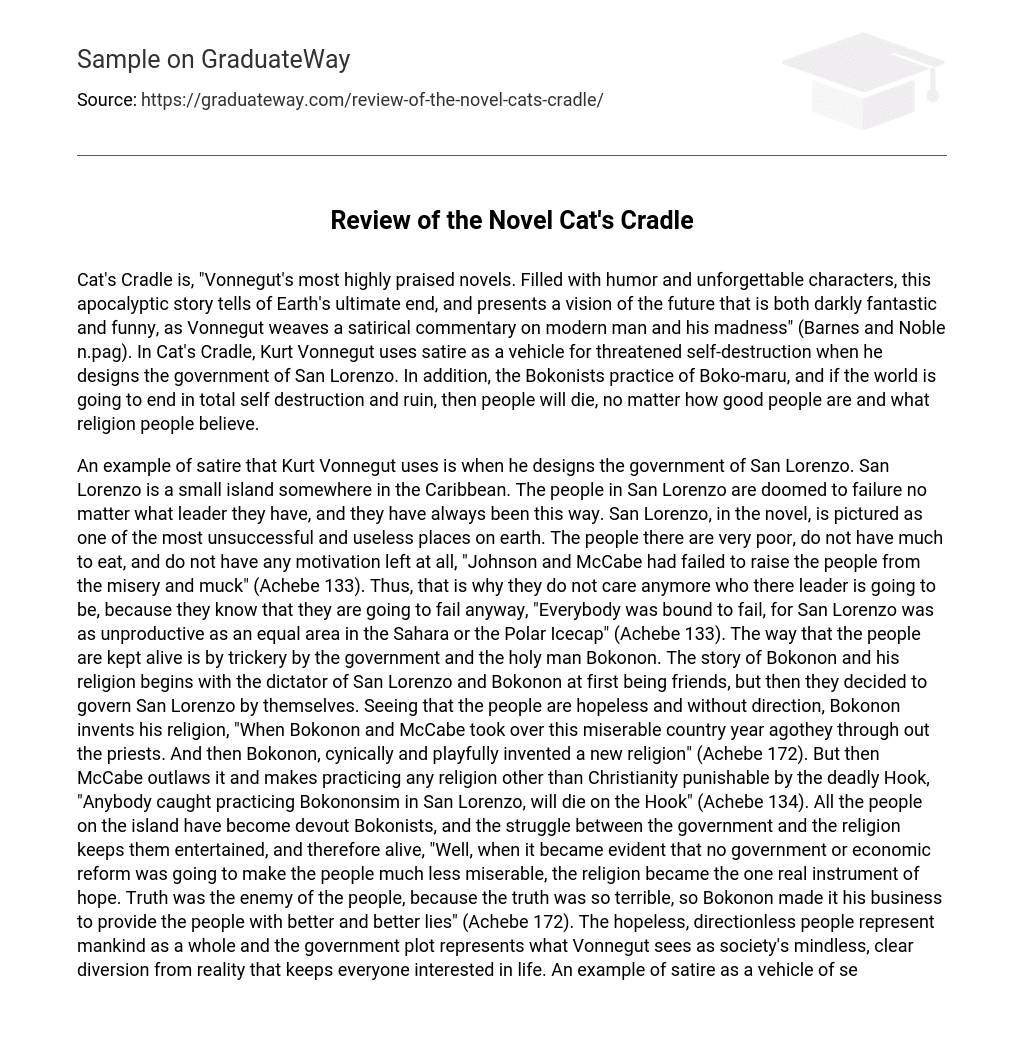Cat’s Cradle, one of Vonnegut’s most highly praised novels, is a story immersed with humor and unforgettable characters. It presents an apocalyptic vision of Earth’s ultimate end that is both darkly fantastic and funny. Vonnegut weaves a satirical commentary on modern man and his madness in this book (Barnes and Noble n.pag). One example of this is seen in the government of San Lorenzo, which Vonnegut designs as a vehicle for threatened self-destruction. Another example can be found in the Bokonists’ practice of Boko-maru. Ultimately, the novel explores the inevitability of death and destruction, regardless of one’s goodness or religious beliefs, if the world is heading towards total ruin.
Using satire, Kurt Vonnegut illustrates the government of San Lorenzo as an example. Located in the Caribbean, San Lorenzo is a small island where its people are doomed to failure regardless of who leads them, a perpetual state they have always been in.
According to the novel, San Lorenzo is portrayed as an incredibly unsuccessful and worthless place. The residents are impoverished, lacking food, and have lost all motivation. As stated by Achebe (133), Johnson and McCabe were unsuccessful in improving the people’s condition. Consequently, the residents have become indifferent to who their leader will be as they believe they will inevitably fail. In fact, San Lorenzo is described as being as unproductive as the Sahara or the Polar Icecap (Achebe 133).
The government and Bokonon use trickery to keep the people alive. Initially, the dictator of San Lorenzo and Bokonon were friends, but they eventually decided to rule the country on their own. Observing that the people are hopeless and lost, Bokonon creates his own religion, stating that “When Bokonon and McCabe took over this miserable country year agothey through out the priests. And then Bokonon, cynically and playfully invented a new religion” (Achebe 172).
But then McCabe bans it and makes it a crime to practice any religion other than Christianity, punishable by the deadly Hook. “Anybody caught practicing Bokononsim in San Lorenzo, will die on the Hook” (Achebe 134). All the inhabitants on the island have embraced Bokonism fervently, and the ongoing conflict between the government and the religion serves as their source of entertainment and, consequently, their reason to live. “Well, when it became apparent that no government or economic reforms could alleviate the people’s misery significantly, the religion became their sole source of hope.”
In the novel, truth is portrayed as the enemy of the people. This is because the truth is deemed so terrible that Bokonon takes it upon himself to supply the people with increasingly superior lies (Achebe 172). The desolate and purposeless individuals symbolize humanity as a whole, while the government plot serves as a representation of society’s mindless and deliberate distraction from reality, which captivates everyone’s attention. One example of self-destructive satire in the story is seen through the practice of Boko-maru by the Bokonists. Boko-maru involves connecting the bare soles of one person’s feet to another person’s bare soles, as a way for “Bokononists [to] intertwine their souls by pressing their feet together” (Achebe 135).
Bokononism, a religion rooted in irony and self-accusation, holds a seemingly futile belief that touching another person’s soles engenders love. Despite its paradoxical nature, Bokononism recognizes the truth in this belief, offering a distinct feature amidst its foundation of falsehoods.
The story exemplifies satire as a means of self-destruction. No matter individuals’ religious beliefs or acts of kindness, global devastation and futility remain inevitable. Ice nine’s destruction of the world highlights Vonnegut’s pessimistic outlook. Despite characters’ desires and actions, an absurd and purposeless force named God ultimately demolishes the world. God, who guided humanity through its wasted and violent history, allowing one man to defiantly taunt Him atop Mount McCabe (Achebe 287).
Kurt Vonnegut’s Cat’s Cradle is a satire that focuses on the events surrounding the dropping of the atomic bomb on Hiroshima in the 1960s. The narrator begins by researching individuals involved in creating the bomb but soon becomes entangled in uncontrollable events leading to a predetermined outcome. Ultimately, the novel ends with the destruction of Earth caused by bizarre coincidences and seemingly random occurrences, all explained by Bokononism, an enigmatic religion. Throughout the story, Vonnegut uses satire to convey his theme of life’s futility. One example is Bokononism, which claims that all religions, including itself, are fabrications and should be disregarded.
Bibliography
- Barnes and Noble. “The Synopsis.” Cat’s Cradle. http://coe.ilstu.edu/labschool/uhigh/english/S1Vonn/vonnpage.htm
- Jr., Kurt Vonnegut. Cat’s Cradle. New York: Bantam Doubleday Dell Publishing: 1963.





